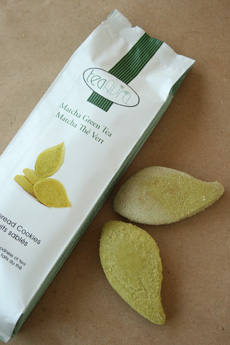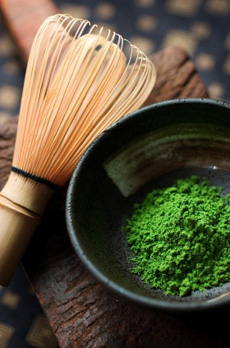RECIPE: Matcha Shortbread Cookies
 Bake ‘em or buy ‘em: matcha shortbread cookies from Tea Aura. Photo by River Soma | THE NIBBLE. |
January 6th is National Shortbread Day. Coming on the heels of new year’s resolutions, where many of us have resolved to eat better, what’s a cookie lover to do?
Make matcha shortbread (or as a default, buy some). While it isn’t health food, matcha shortbread includes a very healthful ingredient—matcha tea. (See the nutritional benefits below). This shortbread recipe is from the Republic Of Tea, which sells matcha tea among hundreds of other varieties. They call the recipe “emerald shortbread” because of the green color. This recipe also includes ground almonds (protein—more nutrition!). You can use a shamrock cookie cutter for St. Patrick’s Day, a flower cookie cutter for spring or a Christmas tree cookie cutter for Christmas. Ingredients |
|
|
Preparation 1. CREAM together the butter and powdered sugar. Mix in the egg yolk. In another bowl, combine the flour, ground almonds and matcha. Add to the first bowl and stir until the mixture forms a ball. 2. ROLL into a 2-inch-wide log. Wrap and place in the freezer for 40 minutes until firm. 3. PREHEAT the oven to 350°F. Line a baking sheet with parchment paper. Using a sharp knife, cut the log into 1/4-inch slices and arrange on the prepared baking sheet. Bake for 9 minutes, or until the cookies just begin to turn golden at the edges. Let rest for 5 minutes before transferring to a rack to cool completely. |
||
|
WHAT IS MATCHA TEA Matcha is a powdered green tea with the consistency of talc that is used in the Japanese tea ceremony, or cha no yu. The leaves for matcha are ground like flour in a stone mill. The powder is then whisked into water. (Here’s the whisk [chasen] that you can use to make your own. Powdered tea is the original way in which tea was prepared in Japan. The steeping of dried tea leaves in boiling water didn’t begin until the Ming Dynasty (1368-1644). Matcha tea has a wonderful aroma, a creamy, silky froth and a rich, mellow taste. It contains a higher amount of nutrients (vitamins, minerals, L-theanine amino acids, polyphenols, chlorophyll and fiber) than other teas, including steeped green tea. Matcha tea is expensive, but worth it if you love the flavor of matcha tea. According to MatchaSource.com, the price is a function of production costs. |
 Matcha tea with the chasen, or whisk, used to stir it into a frothy beverage. The greener the matcha, the higher the quality. Photo courtesy Tafu | New York. |
|
|
Only the youngest, sweetest leaves are used. Covering the fields with bamboo mats (tarps) to create the shade-grown tea weakens the tea plants, and a longer recovery period is needed before they can be harvested again. At the factory, the stone grinders work slowly in order to maintain the nutrients in the tea, including the amino acid, L-theanine, which focuses the brain; it may help the body’s immune response to infection. Each grinder produces only about 40 grams of matcha in an hour. That being said, there are varying qualities of matcha tea. The deeper green color, the higher quality the matcha.
|
||


